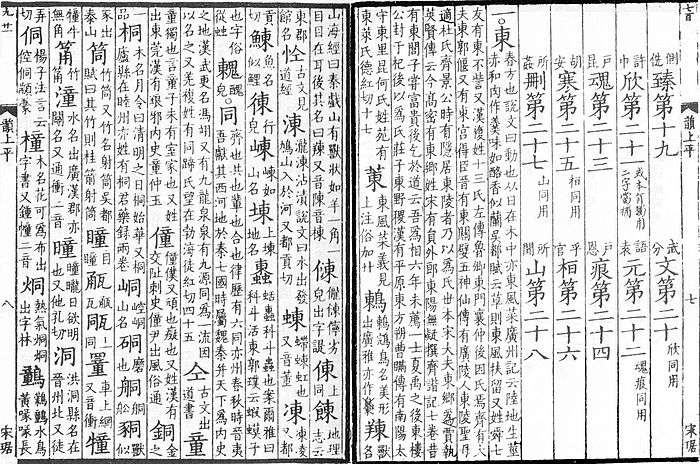Guangyun

The Guangyun (Kuang-yun; simplified Chinese: 广韵; traditional Chinese: 廣韻; pinyin: Guǎngyùn; Wade–Giles: Kuang3-yün4; literally: "Broad Rimes") is a Chinese rime dictionary that was compiled from 1007 to 1008 under the auspices of Emperor Zhenzong of Song. Chen Pengnian (陳彭年, 961–1017) and Qiu Yong (邱雍) were the chief editors. It is a revision and expansion of the influential Qieyun rime dictionary of 601, and was itself later revised as the Jiyun. Until the discovery of an almost complete early 8th century edition of the Qieyun in 1947, the Guangyun was the most accurate available account of the Qieyun phonology, and was heavily used in early work on the reconstruction of Middle Chinese. It is still used as a major source.[1][2]
The Guangyun has a similar layered organization to the Qieyun:
- The dictionary is split into four tones in five volumes, two for the Middle Chinese level tone (平聲) and one each for the three oblique tones, rising (上聲), departing (去聲) and entering (入聲).
- Each tone is split into rimes, with a total of 206 final rimes, increased from 193 in the Qieyun.
- Each rime is divided into groups of homophonous characters, with the pronunciation of each group given by a fanqie formula.
The dictionary has a total of 26,194 character entries, each containing a brief explanation of the character's meaning.[3]
The Unihan database incorporates the "SBGY" (Songben Guangyun; "Song edition Guangyun") dataset with 25,334 head-entries for 19,583 characters.[4]
References
- ↑ Baxter, William H. (1992). A Handbook of Old Chinese Phonology. Berlin: Mouton de Gruyter. pp. 38–39. ISBN 978-3-11-012324-1..
- ↑ Norman, Jerry (1988). Chinese. Cambridge: Cambridge University Press. p. 25. ISBN 978-0-521-29653-3.
- ↑ Teng, Ssu-yü; Biggerstaff, Knight (1971). An Annotated Bibliography of Selected Chinese Reference Works (3rd ed.). Cambridge, MA: Harvard University Press. p. 146. ISBN 978-0-674-03851-6.
- ↑ Jenkins, John H.; Cook, Richard (2010). "Unicode Standard Annex #38: Unicode Han Database". Unicode Consortium.
External links
| Wikimedia Commons has media related to Guangyun. |
- Songben Guangyun, with dictionary lookup – Chinese Text Project
- GuangYun Initials and Rhymes, Dylan W.H. Sung
- Songben Guangyun in electronic form
- Yonh Tenx Myangx 韻典網 (Rhyme Dictionary Website)